One of the most colourfully eye-catching birds with the most vibrant calls to visit our garden is the truly gorgeous Purple-crested Turaco.
Turacos are endemic to Sub-Saharan Africa where 23 species are recognised: 17 colourful forest and woodland species, 5 savannah species (all predominantly grey or brown in colour) and the West African Great Blue Turaco. Although usually regarded as having sister family status with cuckoos recent DNA analysis suggests that the turaco family has no close living relatives.
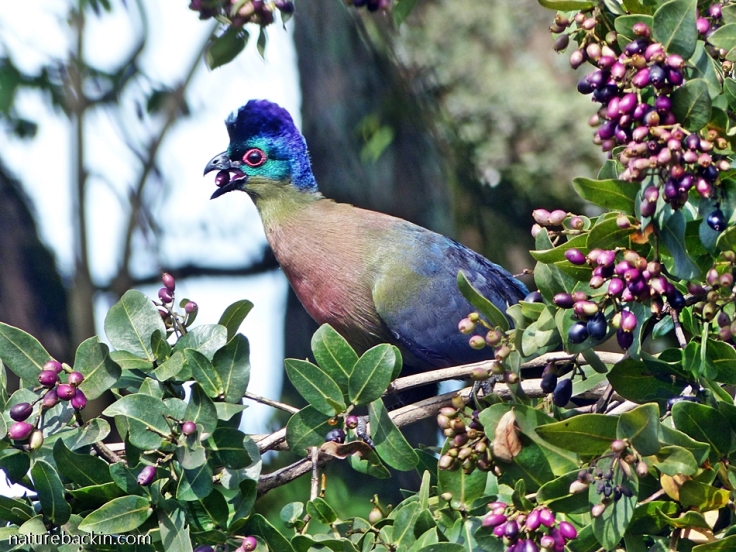
A Purple-crested Turaco eating fruits from an Umdoni or Waterberry (Syzigium cordatum) tree in our garden. This photo was taken from a window as generally these birds are very cautious and do not like being approached
Turacos are mostly fructivorous and play a role as seed dispersers. In addition to eating fruit, some may eat other plant parts such as leaf buds and flowers, as well as caterpillars, insects and molluscs. As a misnomer, the two so-called plantain eaters do not eat bananas, at least not when in the wild. The forest and woodland species are arboreal and even the savannah species require acacia scrub. All species of turaco need to live in proximity to sources of water.

A shy Purple-crested Turaco at a birdbath in our garden. I had to be quite patient to get this photograph as they are very wary when they come down to drink
The Purple-crested Turaco occurs in dense woodland and in riverine and coastal forest. More so than many other species of turaco it has managed to adapt to utilising alien vegetation and suburban gardens. A few decades ago Purple-crested Turaco were seldom seen (or heard) in our local suburban environment but now they are resident. Perhaps this change is as a result of the destruction of adjacent woodland habitats?
Apart from coming down to ground to drink, Purple-crested Turaco keep mostly to the tree canopy where they are surprisingly agile, running and bounding along branches in a distinctive manner. Despite their striking colours they can be hard to see as they are usually concealed by foliage. It is only when they fly that the brilliant scarlet of their primary wing feathers is breathtakingly obvious.
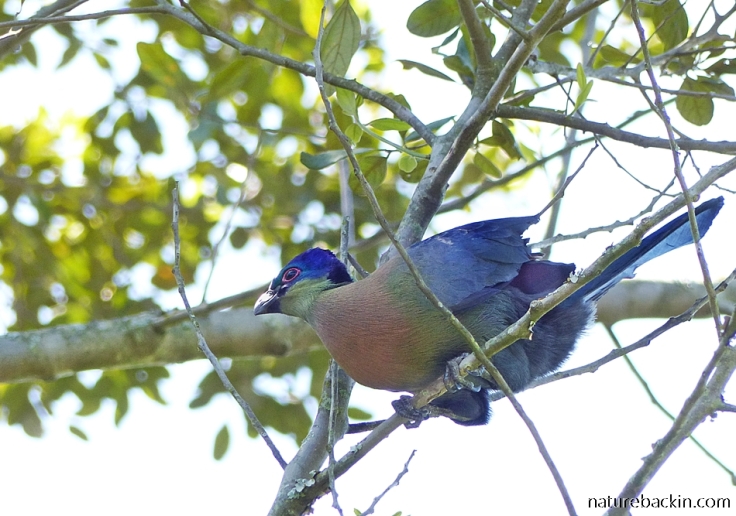
Like other turacos, the Purple-crested Turaco is an agile climber. This bird was selecting twigs and sticks to break off to carry to where it was building its nest in a nearby tree
Unfortunately for the forest and woodland species of turaco, their brilliant colours have led to them being hunted (historically and currently) for their colourful feathers and they are highly sought after for the captive-bird trade with thousands of wild birds being trapped each year for export. For every wild bird that reaches its destination alive, hundreds of birds die in the process of being trapped or while kept inhumanely confined. Some zoos and aviaries are adopting captive breeding programs for some species of turaco, but the trade is poorly regulated if at all. Some species are also hunted for meat. Habitat destruction is another reason for declining turaco numbers with three species, each occurring in restricted ranges, currently ranked as Near Threatened/Threatened/Endangered.
The Purple-crested Turaco occurs in the wild from the eastern regions of South Africa northwards through several eastern and central countries to Tanzania, with an isolated population existing in Kenya. Because of their widespread distribution, although overall their numbers are diminishing, their status is evaluated as Least Concern. In Kwa-Zulu Natal they are found in suitable habitats at lower altitudes.
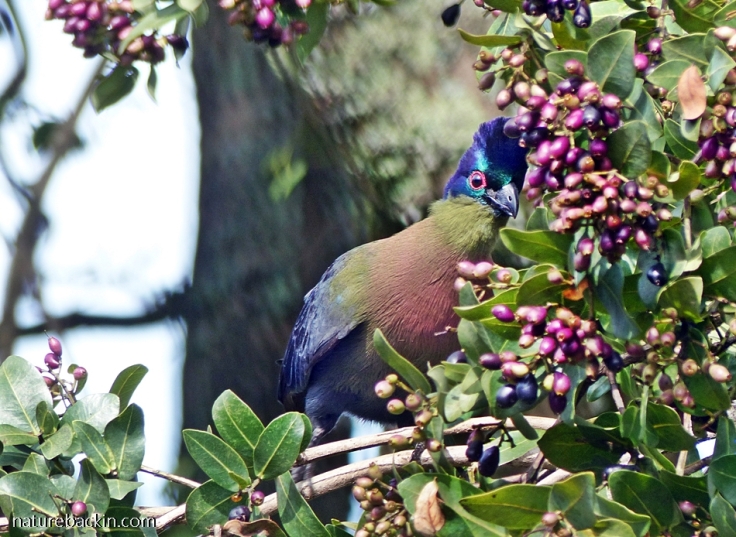
A Purple-crested Turaco showing its characteristically muscular stance while foraging for berries
Turacos forage alone, in pairs or in small groups. They are territorial and gregarious and can remain in family groups for a long time. Adults can be combative around the breeding season. They are monogamous, solitary nesters with both parents involved in raising their young.
I have seen (and heard) three other species of turaco in Southern Africa – Livingstone’s Turaco (at Lake Sibaya in Maputaland in north-eastern KwaZulu-Natal, although not clearly enough to photograph it); Knysna Turaco (in the mistbelt forests of the KwaZulu-Natal Midlands); and the Grey Go-away-bird (in nature parks in Botswana and Zimbabwe and also in Johannesburg gardens. In the late 1970s it expanded its range into suburban areas in Johannesburg and Pretoria).
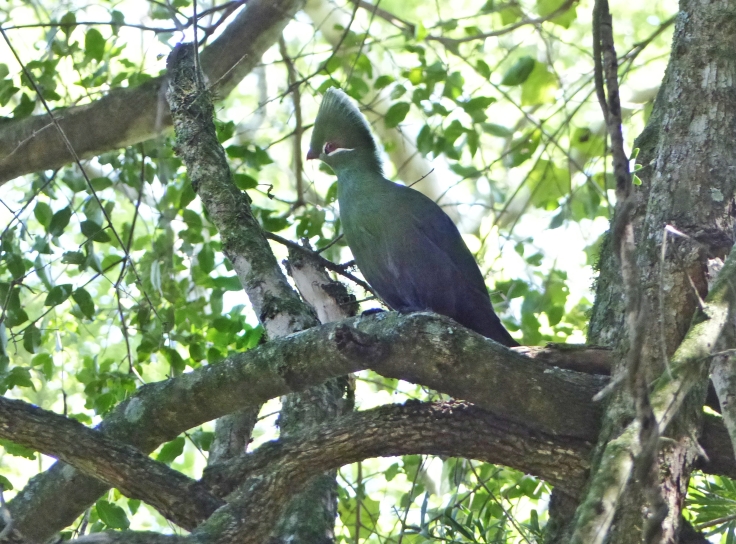
An elusive Knysna Turaco that I managed to photograph in mistbelt forest in the Dargle area in the KwaZulu-Natal Midlands. Although their presence is often evident from their distinctive calls, sightings are usually just glimpses of them as the flit about in the high tree canopy. The Knysna Turaco occurs only in South Africa

The highly vocal Grey Go-away-bird is so named as its call is a loud and often repeated “g-way”. Known as the Kwévoël in Afrikaans, kwé perhaps better evokes the call of these birds. Also known as the Gray Loerie, it is an example of one the savannah species of turaco. I took this photograph of a bird calling – while it foraged together with its mate in a tall shrub – in the Khama Rhino Santuary in Botswana
Although the name turaco has been adopted officially in South Africa in order to bring the naming in line with international naming conventions, here in South Africa we still tend to refer to turacos as loeries (anglicised to louries). The Dictionary of South African English explains that that origin of the Afrikaans word loerie is “from South African Dutch, from Dutch lori, adaptation of Malay luri (dialectal form of nuri parrot)”. I suppose that back in the day, because of their colourful feathers they were thought to be parrot-like.
Currently, now that it is springtime, the Purple-crested Turacos in our neighbourhood are especially vocal, particularly in the early mornings and the late afternoons. Sometimes birds can get quite excited when calling and when other birds respond by calling back. Last week, I managed to get a photograph of a loerie calling from high-up in a Pigeonwood (Trema orientalis) in our garden.
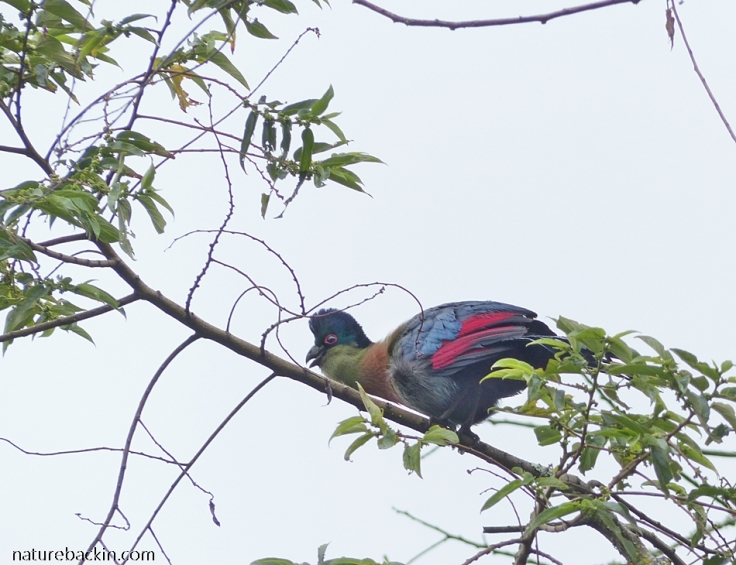
A Purple-crested Turaco calling from a Pigeonwood tree in our garden
Although the light was not that good on a dull day and although the bird was quite a distance away, I decided to try videoing the bird while it was calling and the result is below. The bird broke off from calling to preen and wing stretch, perhaps to impress the other birds in the vicinity that were calling back.
Sources:
BirdLife International (2019) Species factsheet: Gallirex porphyreolophus. http://www.birdlife.org; Chittenden, Hugh, Davies, Greg & Weiersbye, Ingrid. 2016. Roberts Bird Guide: Illustrating nearly 1,000 Species in Southern Africa (2nd edition). Cape Town: Jacana; “Musophagiformes (Turacos and Plantain Eaters).”Grzimek’s Animal Life Encyclopedia. Encyclopedia.com. https://www.encyclopedia.com/environment/encyclopedias-almanacs-transcripts-and-maps/musophagiformes-turacos-and-plantain-eaters; Roberts VII Multimedia PC Edition. 1997-2016 Southern African Birding. For details go to http://www.sabirding.co.za/roberts7/portal.html
Posted by Carol









February 9, 2020 at 10:04 pm
On my gosh!😊
LikeLiked by 1 person
February 10, 2020 at 7:14 pm
🙂
LikeLike
October 12, 2019 at 7:42 pm
Beautiful❤❤❤❤❤
LikeLike
October 12, 2019 at 8:36 pm
Thanks so much – and yes it is a phenomenally beautiful bird 🙂
LikeLiked by 1 person
October 8, 2019 at 8:57 pm
Longest year of my life waiting…haha
LikeLiked by 1 person
October 10, 2019 at 3:47 pm
🙂 Hope you find other diversions in the meantime!
LikeLiked by 1 person
October 10, 2019 at 8:20 pm
Oh yes…if I don’t, I go nuts. Haha.
LikeLiked by 1 person
October 6, 2019 at 2:47 pm
WOW, just WOW!! this is in your backyard??? The video was wonderful too. All I can see in our backyard are squirrels. Not that they aren’t cute, but all I can think about is them chewing the bark of our trees. haha
LikeLiked by 1 person
October 6, 2019 at 7:56 pm
Thanks, and I am glad you enjoyed the lovely Turaco 🙂 They are gorgeous though I also get a kick out the other visiting birds – each has its own beauty. We don’t have squirrels in this part of South Africa. I didn’t know about them chewing bark. The biggest bark chewers visiting here are porcupines but only a few species of trees seem to attract this behaviour, otherwise they seem to prefer tubers.
LikeLiked by 1 person
October 6, 2019 at 8:08 pm
We will be in South Africa next summer – I am sooo looking forward to it. Its going to be a LONG year 🙂
LikeLiked by 1 person
October 7, 2019 at 7:08 pm
Oh that’s great you will be visiting SA. Have you decided on where and what yet? So much to choose from. Still a long way ahead …
LikeLiked by 1 person
October 7, 2019 at 8:27 pm
We will be in Cape Town and Timbavati….Victoria Falls and the Okavango Delta – I can hardly contain myself with excitement!!
LikeLiked by 1 person
October 8, 2019 at 8:31 pm
It all should be great. I think that the Okavango Delta is likely about the closest thing to paradise on Earth 🙂
LikeLiked by 1 person
September 23, 2019 at 5:51 pm
What an amazing colorful bird! Great job being patient. 😊
LikeLiked by 1 person
September 26, 2019 at 6:41 pm
Thanks Irene – perhaps more luck than actual patience involved 🙂
LikeLiked by 1 person
September 14, 2019 at 6:27 am
It’s really an extraordinary bird with an unmistakable shouting! Love your video!!
LikeLiked by 1 person
September 14, 2019 at 8:29 pm
Thanks Simone. The call is a bit like shouting – I was pleased to be able to capture it on a video.
LikeLiked by 1 person
September 13, 2019 at 6:39 pm
I LOVE the Purple Crested Turaco. Here they call them Kolo-kolo, a bit like the sound they make.
LikeLiked by 1 person
September 14, 2019 at 8:26 pm
Thanks Liza – Kolo-kolo is an appropriate name for them. I might borrow it from now on.
LikeLiked by 1 person
September 16, 2019 at 8:43 am
I also started using it!
LikeLiked by 1 person
September 13, 2019 at 4:04 pm
What a stunning garden visitor!
LikeLiked by 1 person
September 14, 2019 at 8:24 pm
Thanks Brian – it is stunning. (Is it not interesting that you had ‘Blue, blue electric blue’ as a post title recently, and I had ‘sound and vision’?)
LikeLiked by 1 person
September 14, 2019 at 8:41 pm
Nothing like a bit of Bowie 😉
LikeLiked by 1 person
September 14, 2019 at 8:53 pm
Absolutely 🙂
LikeLike
September 13, 2019 at 9:11 am
Wow Carol never seen a bird like this and what a lovely purple color, too good. Thanks so much for your marvelous write up and share.
LikeLiked by 1 person
September 14, 2019 at 8:10 pm
Thanks Kamal. It is a bird with a big wow factor, and its colours, especially the purple, are almost incredible.
LikeLike
September 15, 2019 at 3:51 am
Yes so true lovely color too. Welcome 😊😊 😊😊
LikeLiked by 1 person
September 13, 2019 at 7:46 am
Again, I am amazed by your photographs. And thank you for your detailed information on these beautiful birds. The Knysna touraco [aka Knysna loerie] is often heard and less often seen at Hogsback. More recently I have heard and seen them in Grahamstown-Makana.
LikeLiked by 1 person
September 14, 2019 at 8:08 pm
Thanks Mariss. I have also heard them in the Hogsback area (a long time back), and also in the coastal forests in the Eastern Cape. Interesting that they are becoming more apparent in Grahamstown.
LikeLiked by 1 person
September 13, 2019 at 7:44 am
Wow! I can’t even imagine what it must be like to have such glorious creatures grace a garden. I can see definite resemblances to fairytale/fictional birds in him! The birds are fortunate too that your space is so safe and welcoming to them. Thank you for introducing him to us and for the fascinating information about this and related species.
LikeLiked by 1 person
September 14, 2019 at 8:03 pm
Thanks Theresa. Yes they do have a fairytale fantasy quality about them. They are not birds that are easy to take for granted. It is always a thrill to see them and its nice to see that they seem to be becoming a little more relaxed about using the birdbaths.
LikeLiked by 1 person
September 13, 2019 at 5:53 am
What a cool bird. Looks like it belongs in a night club somewhere, partying to disco music. How nice to have them in your garden. I’m amazed that you were able to get such good photos, especially if the bird is as skittish as you say.
LikeLiked by 1 person
September 14, 2019 at 8:00 pm
I love the description – their kind of rakish glamour would not be out of place partying at a night club 🙂 They are wary so the best photos I have of them are taken from a window where I was more concealed from their view. Usually its they who are concealed from me 🙂
LikeLiked by 1 person
September 16, 2019 at 5:20 am
Well, you outwitted them this time, or at least that’s the way I think of it when I finally get a decent photo of something elusive.
LikeLiked by 1 person
September 13, 2019 at 4:19 am
What a joy your post has been to read. We are blessed with a pair of Knysna Turacos (always a Loerie!) in our neighbourhood. Yesterday one came within three metres of where I was sitting quietly in our garden – possibly to feed on the apples I had put out – but moved off as soon as it noticed my presence. I always feel so privileged to see them. Have only seen the Purple ones in the Kruger Park (Skukuza).
LikeLiked by 1 person
September 14, 2019 at 7:57 pm
How fantastic to have a Knysna Loerie (agreed, yes Loerie!) approach so close! They have a different beauty to the Purple-crested, but both are absolutely stunning to see, and a special privilege to have them visiting one’s garden.
LikeLike
September 13, 2019 at 2:55 am
Oh Carol, the Loeries are beautiful birds – even the Kwevoel – and what would our forests be without their “kok-kok-kok” in the misty early morning!?
You have a really wonderful collection of images, especially of the beautiful purple-crested species! Yet again I find myself seriously envious of the huge number of very special birds that visit your garden! Thankfully the “Go-away bird”s are regular visitors to our feeder and bird bath.
LikeLiked by 1 person
September 14, 2019 at 7:52 pm
Yes, hearing Loeries calling in the forests is always fantastic. The Gray Loerie is beautiful and full of character too. I was amazed to see how comfortable they seem to be in Joburg gardens.
LikeLiked by 1 person
September 15, 2019 at 2:15 am
They’ve got the perfect attitude to flourish in GP – Gangster’s Paradise!
LikeLiked by 1 person
September 19, 2019 at 7:16 pm
🙂
LikeLiked by 1 person
September 13, 2019 at 2:03 am
What a gorgeous creature! That flash of red tail feathers was wonderful. To be honest, I’m not sure I’d enjoy having one perched near my bedroom window early in the morning. 🙂
LikeLiked by 1 person
September 14, 2019 at 7:48 pm
It is a treat to have them around and always a thrill to see them.
LikeLiked by 1 person
September 12, 2019 at 8:41 pm
I love the video. I’d decided I would have to go to YouTube to hear this bird in full voice when your post finished by giving us this recording. Great stuff, and what a beautiful bird. How dreadful that it seems to be being hunted – dead or alive.
LikeLiked by 1 person
September 12, 2019 at 8:48 pm
Thanks Margaret. I was lucky to be able to record the sound with a visual of the bird actually calling when not concealed behind foliage as is usually the case!
I was also upset when learning about the cruel trapping and transportation of turacos. I never understand why people want to cage creatures that are born to fly – or to cage any other creatures for that matter.
LikeLiked by 1 person
September 12, 2019 at 8:40 pm
Wow…It’s like a winged rainbow. Captivating, Carol.
LikeLiked by 1 person
September 12, 2019 at 8:41 pm
That is a great description Sandy 🙂
LikeLiked by 1 person
September 12, 2019 at 7:42 pm
What a handsome bird that PCT is. My dog found its call quite intriguing! 😉
LikeLiked by 1 person
September 12, 2019 at 8:04 pm
Yes it is a most handsome bird. It is interesting when recorded sounds intrigue dogs so 🙂
LikeLike
September 12, 2019 at 7:29 pm
A Purple Crested Turaco! Oh, you are so darn lucky! I am green with envy.
LikeLiked by 1 person
September 12, 2019 at 7:58 pm
Yes we are lucky – they are always such a treat to see – and hear!
LikeLike